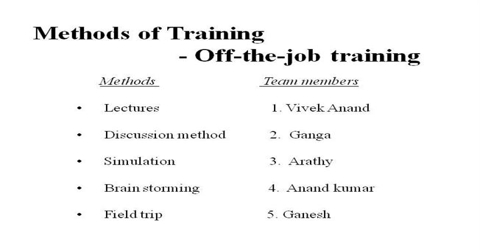TRAINING METHODS
Training is a highly useful tool that can bring an employee into a position where they can do their job correctly, effectively, and conscientiously. There are various methods of training. These are broadly categorized into two groups: On-the-Job and Off-the- Job methods. On-the-Job methods refer to the methods that are applied to the workplace, while the employee is actually working. Off-the-Job methods are used away from the work place.
ON THE JOB METHODS
Apprenticeship Programmes: Apprenticeship programmes put the trainee under the guidance of a master worker. These are designed to acquire a higher level of skill. People seeking to enter skilled traits, to become, for example, plumbers, electricians or iron-workers, are often required to undergo apprenticeship training.
Coaching: In this method, the superior guides and instructs the trainee as a coach. The coach or counselor sets mutually agreed upon goals, suggests how to achieve these goals, periodically reviews the trainees progress and suggests changes required in behavior and performance.
Internship Training: It is a joint programme of training in which educational institutions and business firms cooperate.
Job Rotation: This kind of training involves shifting the trainee from one department to another or from one job to another.
OFF THE JOB METHODS
Class Room Lectures/Conferences: The lecture or conference approach is well adapted to conveying specific information rules, procedures or methods.
Films: They can provide information and explicitly demonstrate skills that are not easily represented by the other techniques.
Case Study: Taken from actual experiences of organisations, cases represent attempts to describe, as accurately as possible real problems that managers have faced.
Vestibule Training: Employees learn their jobs on the equipment they will be using, but the training is conducted away from the actual work floor.













